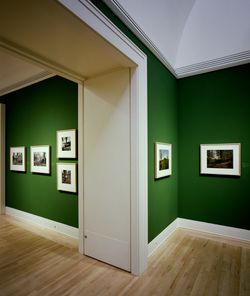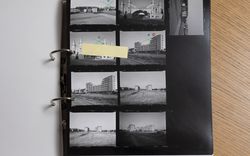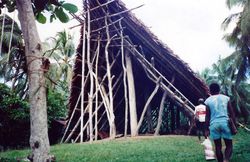archives
Niveau de description archivistique:
Fonds
Fonds John Bird
AP108
Résumé:
The John Bird fonds documents the professional practice of the Westmount-based architect, and includes drawings and photographs of 24 architectural projects carried out in and around Montréal, Québec between 1954 and 1992. The fonds also contains a number of published articles that document John Bird's professional activities. Key projects that are represented include the Canadian Technical Tape Building, St. Laurent (1955-1963), Saint Gabriel's Church, Montréal (1959-1960), and Saint John Brebeuf Church, Lasalle (1962-1966). The fonds also includes numerous projects for Toronto-Dominion Bank buildings (1959-1992) as well as residential designs completed for the Central Mortgage and Housing Corporation (1956-1969).
1942 - 1992
Fonds John Bird
Actions:
AP108
Résumé:
The John Bird fonds documents the professional practice of the Westmount-based architect, and includes drawings and photographs of 24 architectural projects carried out in and around Montréal, Québec between 1954 and 1992. The fonds also contains a number of published articles that document John Bird's professional activities. Key projects that are represented include the Canadian Technical Tape Building, St. Laurent (1955-1963), Saint Gabriel's Church, Montréal (1959-1960), and Saint John Brebeuf Church, Lasalle (1962-1966). The fonds also includes numerous projects for Toronto-Dominion Bank buildings (1959-1992) as well as residential designs completed for the Central Mortgage and Housing Corporation (1956-1969).
archives
Niveau de description archivistique:
Fonds
1942 - 1992
Projet
AP178.S1.1980.PR02
Description:
The project series documents Block 121, better known as Bonjour Tristesse. While the records were held in the office’s archives this project was assigned the number 2/80. This project was one of several projects Siza submitted to the International Architectural Exhibition Berlin competition (International Bauaustellung, IBA, circa 1979-1987), and was Siza’s first international built project. The IBA was an urban renewal strategy for West Berlin and received submissions from several international architects. The IBA divided West Berlin into two parts: IBA Neubau ('new building'), led by Josef Paul Kleihues and IBA Altbau ('old building') led by Hardt-Walherr Hämer. IBA Nuebau's focus was to build new buildings while IBA Altbau's was to renovate existing buildings. The project site for Block 121 was in the district of Kreuzberg, a district on the eastern side of then West Berlin. Due to low rents, there was an influx of immigrants and students to Kreuzberg in the late 1970s. Bonjour Tristesse would serve as a residential complex for a predominantly Turkish immigrant population. In 1980, Hämer invited Siza to submit an entry for this complex to be built on the east side of Kreuzberg beside the Schlesisches Tor train station. Hämer encouraged the participatory model which Siza had become known for from his work with the Servicio Ambulatorio de Apoio Local (SAAL) in Portugal. This project series is arranged in four subseries: AP178.S1.1980.PR02.SS1, Competition, Block 121 (identified as 2/80); AP178.S1.1980.PR02.SS2, Bonjour Tristesse (identified as 2/80 A); AP178.S1.1980.PR02.SS3, Kita [Kindergarten] (identified as 2/80 B); and AP178.S1.1980.PR02.SS4, Senior Club Anziani [Senior citizens’ clubhouse] (identified as 2/80 C). The office’s archivist assigned the number 2/80 to materials related to the competition phase of this project; letters (A, B, and C) were then assigned to each subsequent portion of the project following the competition. All documentation for this project series, including the project subseries, has been kept together to maintain the order of the office’s arrangement.
circa 1980-1990
Block 121, Schlesisches Tor [Block 121, Schlesisches Tor residential complex], Berlin, Germany (1980-1990)
Actions:
AP178.S1.1980.PR02
Description:
The project series documents Block 121, better known as Bonjour Tristesse. While the records were held in the office’s archives this project was assigned the number 2/80. This project was one of several projects Siza submitted to the International Architectural Exhibition Berlin competition (International Bauaustellung, IBA, circa 1979-1987), and was Siza’s first international built project. The IBA was an urban renewal strategy for West Berlin and received submissions from several international architects. The IBA divided West Berlin into two parts: IBA Neubau ('new building'), led by Josef Paul Kleihues and IBA Altbau ('old building') led by Hardt-Walherr Hämer. IBA Nuebau's focus was to build new buildings while IBA Altbau's was to renovate existing buildings. The project site for Block 121 was in the district of Kreuzberg, a district on the eastern side of then West Berlin. Due to low rents, there was an influx of immigrants and students to Kreuzberg in the late 1970s. Bonjour Tristesse would serve as a residential complex for a predominantly Turkish immigrant population. In 1980, Hämer invited Siza to submit an entry for this complex to be built on the east side of Kreuzberg beside the Schlesisches Tor train station. Hämer encouraged the participatory model which Siza had become known for from his work with the Servicio Ambulatorio de Apoio Local (SAAL) in Portugal. This project series is arranged in four subseries: AP178.S1.1980.PR02.SS1, Competition, Block 121 (identified as 2/80); AP178.S1.1980.PR02.SS2, Bonjour Tristesse (identified as 2/80 A); AP178.S1.1980.PR02.SS3, Kita [Kindergarten] (identified as 2/80 B); and AP178.S1.1980.PR02.SS4, Senior Club Anziani [Senior citizens’ clubhouse] (identified as 2/80 C). The office’s archivist assigned the number 2/80 to materials related to the competition phase of this project; letters (A, B, and C) were then assigned to each subsequent portion of the project following the competition. All documentation for this project series, including the project subseries, has been kept together to maintain the order of the office’s arrangement.
Project
circa 1980-1990
En réponse à une commande du CCA, trois photographes contemporains ont consacré six ans à l’interprétation de l’œuvre de Frederick Law Olmsted (1822-1903), qui a marqué l’histoire de l’architecture du paysage en Amérique du Nord. *Frederick Law Olmsted en perspective : Photographies de Robert Burley, Lee Friedlander et Geoffrey James* présente 155 photographies issues de(...)
Salles principales
16 octobre 1996 au 2 février 1997
Frederick Law Olmsted en perspective : Photographies de Robert Burley, Lee Friedlander et Geoffrey James
Actions:
Description:
En réponse à une commande du CCA, trois photographes contemporains ont consacré six ans à l’interprétation de l’œuvre de Frederick Law Olmsted (1822-1903), qui a marqué l’histoire de l’architecture du paysage en Amérique du Nord. *Frederick Law Olmsted en perspective : Photographies de Robert Burley, Lee Friedlander et Geoffrey James* présente 155 photographies issues de(...)
Salles principales
articles
Regard transversal
21 août 2023
Regard transversal
Stefano Boeri à propos de Gabriele Basilico, en conversation avec Stefano Graziani et Bas Princen
Actions:
David Howes, professeur d’anthropologie et directeur du Centre for Sensory Studies de l’université Concordia, aborde de façon sensorielle l’étude d’une série d’intérieurs qu’il a observés au cours de ses recherches anthropologiques et archivistiques. Elles vont de la maison des hommes dans la région du fleuve Sepik en Papouasie-Nouvelle-Guinée à lintérieur exclusivement(...)
Maison Shaughnessy
26 février 2015 , 18h
L’intérieur sensoriel
Actions:
Description:
David Howes, professeur d’anthropologie et directeur du Centre for Sensory Studies de l’université Concordia, aborde de façon sensorielle l’étude d’une série d’intérieurs qu’il a observés au cours de ses recherches anthropologiques et archivistiques. Elles vont de la maison des hommes dans la région du fleuve Sepik en Papouasie-Nouvelle-Guinée à lintérieur exclusivement(...)
Maison Shaughnessy
dessins, photographies
DR2012:0012:075:002
Description:
Box containing printouts with annotations related to the folliwing project: - A Chicago construction (14 printouts, 13 transparencies, 7 drawings); - Front page constructions (8 printouts). Original box included two self-stick notes inscribed in graphite: ARCHIVAL MATERIAL A CHICAGO CONSTRUCTION, and DOCUMENTATION.
1981
Installation plans, installation views, and reproduction of press clippings, A Chicago Construction
Actions:
DR2012:0012:075:002
Description:
Box containing printouts with annotations related to the folliwing project: - A Chicago construction (14 printouts, 13 transparencies, 7 drawings); - Front page constructions (8 printouts). Original box included two self-stick notes inscribed in graphite: ARCHIVAL MATERIAL A CHICAGO CONSTRUCTION, and DOCUMENTATION.
dessins, photographies
1981
Projet
AP178.S1.1979.PR02
Description:
The project series documents the 1979 design entry for the Görlitzer Bad swimming pool. While the records were held in the office’s archives this project was assigned the number 48/70; in the past the office identified the project as number 159. The office assigned the date 1979 for this project. This project was submitted to the International Architectural Exhibition Berlin competition (International Bauaustellung, IBA, circa 1979-1987), an urban renewal strategy for West Berlin, Germany. Siza would later submit proposals to the IBA for Block 70 and 89 (Fränkelufer residential complex), Block 121 (Bonjour Tristesse), Block 11-12 (Kottbusser Damm), Monument to Gestapo victims Prinz- Albrecht-Palais, and a proposal for the Kulturforum. The Görlitzer Bad swimming pool was Siza's first international project and first competition. Preceding the IBA competition, Siza attended the 1976 International Design Zentrum (IDZ) symposium in Berlin, "Stadtstruktur-Stadtgestalt". Brigitte Fleck, responsible for national and international architecture competitions for the Senate of Berlin (1971-1985), invited Siza to participate in the IBA competition to design the swimming pool for Kreuzberg. Fleck had heard of Siza’s participation in the IDZ symposium and became interested in Siza’s work with the Servicio Ambulatorio de Apio Lokal (SAAL). By this time Siza’s work with SAAL had been published in the December 1976 and March 1978 publications of the Lotus International Quarterly Architectural Review (numbers 13 and 18). Fleck felt that Siza's work with SAAL would be relevant to the IBA. In 1979, Siza entered his design for the Görlitzer Bad swimming pool to be built on a vacant area on the east side of Kreuzberg. The design for the pool was strongly opposed by the public because the dome over the main swimming pool was said to resemble a mosque. This area of Kreuzberg was largely populated by Turkish Muslims and there was hostility towards this immigrant community. Although Siza’s entry went through the first round of the IBA competition, it did not win the competition and was only awarded a special prize. The project series contains sketches and studies, as well as conceptual and design development drawings of elevations, site plans, and floor plans. Documentation for the competition includes site plans for the competition and a strata plan. The photographs, negatives, contact sheets, and slides mostly document the model and drawings for the project.
1978-1979
Piscina de "Görlitzer Bad" Kreuzberg, Berlim Oeste [Görlitzer Bad swimming pool], Berlin, Germany (1978-1979)
Actions:
AP178.S1.1979.PR02
Description:
The project series documents the 1979 design entry for the Görlitzer Bad swimming pool. While the records were held in the office’s archives this project was assigned the number 48/70; in the past the office identified the project as number 159. The office assigned the date 1979 for this project. This project was submitted to the International Architectural Exhibition Berlin competition (International Bauaustellung, IBA, circa 1979-1987), an urban renewal strategy for West Berlin, Germany. Siza would later submit proposals to the IBA for Block 70 and 89 (Fränkelufer residential complex), Block 121 (Bonjour Tristesse), Block 11-12 (Kottbusser Damm), Monument to Gestapo victims Prinz- Albrecht-Palais, and a proposal for the Kulturforum. The Görlitzer Bad swimming pool was Siza's first international project and first competition. Preceding the IBA competition, Siza attended the 1976 International Design Zentrum (IDZ) symposium in Berlin, "Stadtstruktur-Stadtgestalt". Brigitte Fleck, responsible for national and international architecture competitions for the Senate of Berlin (1971-1985), invited Siza to participate in the IBA competition to design the swimming pool for Kreuzberg. Fleck had heard of Siza’s participation in the IDZ symposium and became interested in Siza’s work with the Servicio Ambulatorio de Apio Lokal (SAAL). By this time Siza’s work with SAAL had been published in the December 1976 and March 1978 publications of the Lotus International Quarterly Architectural Review (numbers 13 and 18). Fleck felt that Siza's work with SAAL would be relevant to the IBA. In 1979, Siza entered his design for the Görlitzer Bad swimming pool to be built on a vacant area on the east side of Kreuzberg. The design for the pool was strongly opposed by the public because the dome over the main swimming pool was said to resemble a mosque. This area of Kreuzberg was largely populated by Turkish Muslims and there was hostility towards this immigrant community. Although Siza’s entry went through the first round of the IBA competition, it did not win the competition and was only awarded a special prize. The project series contains sketches and studies, as well as conceptual and design development drawings of elevations, site plans, and floor plans. Documentation for the competition includes site plans for the competition and a strata plan. The photographs, negatives, contact sheets, and slides mostly document the model and drawings for the project.
Project
1978-1979
Projet
AP012.S1.SS1.D1
Description:
Le dossier est constitué d'un dessin de présentation relié au projet de Dépôt d'archives.
s.d.
Un dépôt d'archives
Actions:
AP012.S1.SS1.D1
Description:
Le dossier est constitué d'un dessin de présentation relié au projet de Dépôt d'archives.
Dossier 1
s.d.
Projet
AP178.S1.1979.PR06
Description:
The project series documents the 1979 design entry for Block 70 and 89, also known as the Fränkelufer residential complex. While the records were held in the office’s archives this project was assigned the number 55/70. The office assigned the date 1979 for this project. This project was submitted to the International Architectural Exhibition Berlin competition (International Bauaustellung, IBA, circa 1979-1987), an urban renewal strategy for West Berlin, Germany. Six months prior to submitting the design for Block 70 and 89 Siza submitted a design for the Görlitzer Bad swimming pool, which did not win the competition but received a special prize. Siza later submitted proposals to the IBA for Bonjour Tristesse (Block 121), Monument to Gestapo victims Prinz-Albrecht-Palais, Block 11-12 (Kottbusser Damm), and the Kulturforum, all of which are documented in this fonds. The IBA divided West Berlin into two parts: IBA Neubau ('new building'), led by Josef Paul Kleihues, and IBA Altbau ('old building') led by Hardt-Walherr Hämer. IBA Nuebau's focus was to build new structures while IBA Altbau's was to renovate existing buildings. The competition site for Block 70 and 89 was located on the west side of Kreuzberg, a district on the eastern edge of West Berlin. Although this project was part of the Altbau section, it nonetheless required building new housing complexes, which was generally under the purview of the Neubau section (Mota, "An archaeology of the ordinary" 299). Siza won second prize in the competition for his design of Block 70 and 89. This design proposal is said to have prepared Siza's ideas for his first international built project, Block 121 (Mathur, "The migrant's time"). The project series contains sketches and studies, which include notes. Several of the project sketches also include sketches of people. Documenting the design proposal are site plans, elevations, interior elevations, and floor plans. Photographs, negatives, contact sheets, and slides depict the project site and surrounding area as well as the model and drawings. Additionally there are panoramic photomontages of the project site. Please note that documentation for this project series is housed with documentation on Block 11-12 in file AP178.S1.1980.PR03.008, in the order it was kept by the office. Documentation for Block 70 and 89 includes an invitation to the competition, recommendations from the IBA advisory council, and other information regarding the competition.
1976-1982
Blocke 70 und 89, Kreuzberg, Fränkelufer [Fränkelufer residential complex], Berlin, Germany (1976-1982)
Actions:
AP178.S1.1979.PR06
Description:
The project series documents the 1979 design entry for Block 70 and 89, also known as the Fränkelufer residential complex. While the records were held in the office’s archives this project was assigned the number 55/70. The office assigned the date 1979 for this project. This project was submitted to the International Architectural Exhibition Berlin competition (International Bauaustellung, IBA, circa 1979-1987), an urban renewal strategy for West Berlin, Germany. Six months prior to submitting the design for Block 70 and 89 Siza submitted a design for the Görlitzer Bad swimming pool, which did not win the competition but received a special prize. Siza later submitted proposals to the IBA for Bonjour Tristesse (Block 121), Monument to Gestapo victims Prinz-Albrecht-Palais, Block 11-12 (Kottbusser Damm), and the Kulturforum, all of which are documented in this fonds. The IBA divided West Berlin into two parts: IBA Neubau ('new building'), led by Josef Paul Kleihues, and IBA Altbau ('old building') led by Hardt-Walherr Hämer. IBA Nuebau's focus was to build new structures while IBA Altbau's was to renovate existing buildings. The competition site for Block 70 and 89 was located on the west side of Kreuzberg, a district on the eastern edge of West Berlin. Although this project was part of the Altbau section, it nonetheless required building new housing complexes, which was generally under the purview of the Neubau section (Mota, "An archaeology of the ordinary" 299). Siza won second prize in the competition for his design of Block 70 and 89. This design proposal is said to have prepared Siza's ideas for his first international built project, Block 121 (Mathur, "The migrant's time"). The project series contains sketches and studies, which include notes. Several of the project sketches also include sketches of people. Documenting the design proposal are site plans, elevations, interior elevations, and floor plans. Photographs, negatives, contact sheets, and slides depict the project site and surrounding area as well as the model and drawings. Additionally there are panoramic photomontages of the project site. Please note that documentation for this project series is housed with documentation on Block 11-12 in file AP178.S1.1980.PR03.008, in the order it was kept by the office. Documentation for Block 70 and 89 includes an invitation to the competition, recommendations from the IBA advisory council, and other information regarding the competition.
Project
1976-1982
documents textuels
ARCH255601
Description:
24 files - R-Z alphabetical files - Royal Architectural Institute of Canada, R miscellaneous; S miscellaneous; Transcendental Meditation Soc., telex messages, travelling exhibition, trip file, T miscellaneous; U-Z miscellaneous including University of Calgary archived inventory of drawings; Who's Who correspondence and biographical sketches.
1979-1986
R-Z alphabetical files
Actions:
ARCH255601
Description:
24 files - R-Z alphabetical files - Royal Architectural Institute of Canada, R miscellaneous; S miscellaneous; Transcendental Meditation Soc., telex messages, travelling exhibition, trip file, T miscellaneous; U-Z miscellaneous including University of Calgary archived inventory of drawings; Who's Who correspondence and biographical sketches.
documents textuels
1979-1986


